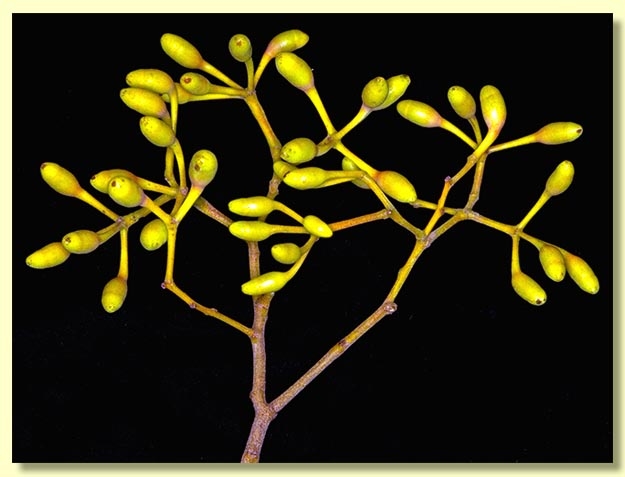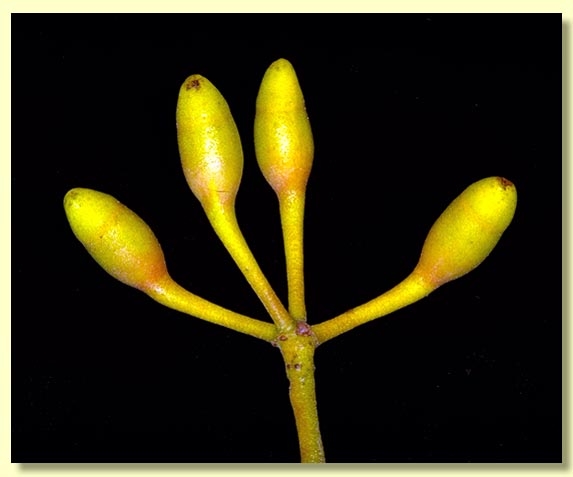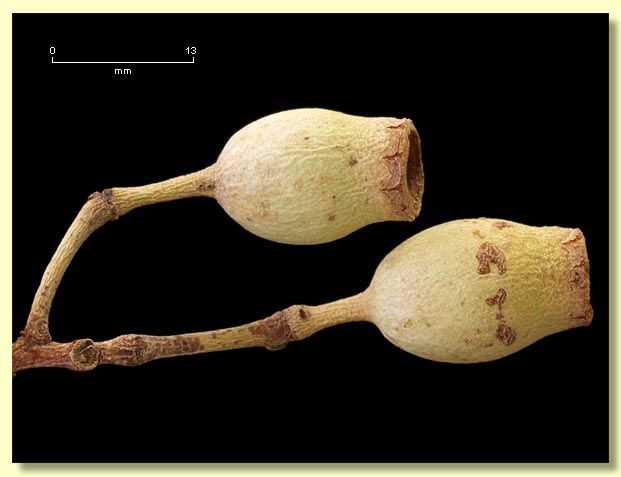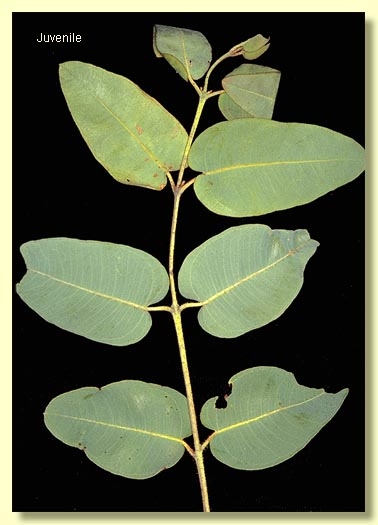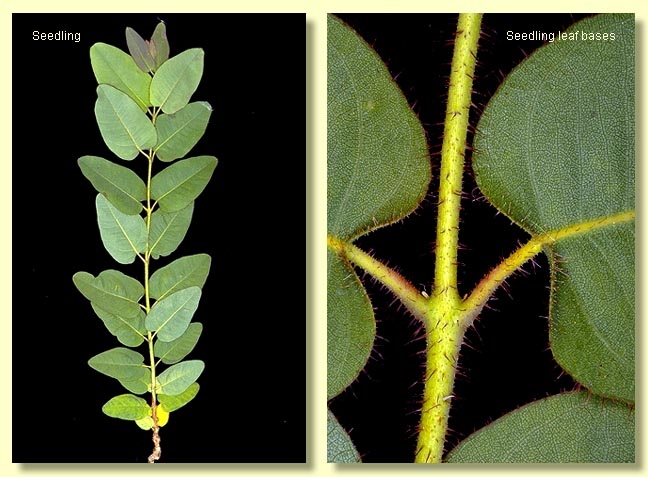Euclid - Online edition
Corymbia bleeseri
Corymbia | Rufaria
Corymbia bleeseri (Blakely) K.D.Hill & L.A.S.Johnson, Telopea 6: 288 (1995).
Eucalyptus bleeseri Blakely, J. & Procs. Roy. Soc. New South Wales 61: 175 (1927). T: Northern Territory: Darwin, Feb. 1927, D.W.C.Shiress & F.A.K.Bleeser s.n.; lecto: NSW.
Eucalyptus terminalis var. longipedata Maiden & Blakely in J.H. Maiden, Crit. Revis. Eucalyptus 7: 407 (1928). T: Northern Territory: Darwin, 14 May 1917, C.E.F.Allen 181; holo: NSW.
Tree to20 m tall. Forming a lignotuber.
Bark thin, rough, grey or grey-brown and red, scaly tessellated, variably extending from the base only to all of trunk, smooth above, slightly powdery or not, white to cream or pale grey.
Branchlets lack oil glands in the pith; smooth.
Juvenile growth (coppice or field seedlings to 50 cm): stems rounded in cross-section, setose with bristle-glands to ca 3 mm long; juvenile leaves always petiolate, opposite for many nodes, predominantly cordate to ovate but may be ± lanceolate to oblong or even almost orbicular, (3.3)4–14 cm long, 2.5–6.5 cm wide, base lobed to rounded, rarely peltate or truncate, apex rounded and apiculate or broadly pointed, dull greyish green, with sparse bristle-glands and some white simple hairs scattered on both surfaces.
Adult leaves alternate, petioles 1–2.8 cm long; blade lanceolate to falcate, 7.5–15(18.4) cm long, 0.9–2.7 cm wide, base tapering to petiole, margin entire, apex pointed, concolorous or slightly discolorous, maturing very glossy, green, smooth, side-veins greater than 45° to midrib, reticulation very dense, intramarginal vein visible but close to margin, oil glands usually present, island or intersectional, one per areole.
Inflorescence terminal compound, peduncles relatively slender, 0.5–3 cm long, buds 7 per umbel, pedicels 0.6–3 cm long. Mature buds ovoid to almost cylindrical (0.8–1.5 cm long, 0.5–0.8 cm wide), smooth, scar absent (both opercula shed together at flowering), operculum rounded to bluntly conical, stamens inflexed, all fertile, anthers oblong, dorsifixed, versatile, dehiscing by longitudinal slits, style long and straight, stigma blunt and long-papillose, locules 4, the placentae each with ca 5 indistinct ovule rows. Flowers creamy white.
Fruit pedicellate (pedicels (0.6)1–3 cm long), thick-walled, barrel-shaped and sometimes with a slight apical constriction, rim not flared, 1.5–2.5 cm long, 1–1.5(1.8) cm wide, ca 1.5 times longer than wide, smooth, disc descending vertically, valves 4, enclosed.
Seeds brown, 7–13 mm long, ellipsoidal with terminal wing, hilum ventral.
Cultivated seedlings (measured at ca node 10): cotyledons large, reniform; stems rounded in cross-section, setose with bristle-glands and also with short white simple hairs arising from the epidermis; leaves at least shortly petiolate (petioles to 1.4 cm), opposite for at least 16 nodes, ovate to cordate or lanceolate-elliptic, 5–10 cm long, 1.8–6 cm wide, base rounded on lower leaves, lobed to rounded higher up stem, apex rounded to pointed, dull, green, slightly discolorous, setose with bristle-glands and short white simple hairs on both surfaces.
Flowering has been recorded in March, April, May and June.
A common bloodwood tree found in the monsoonal northern Kimberley region of Western Australia, e.g. between Drysdale River and Kalumburu, and the Top End of the Northern Territory north from Dorisvale and Maranboy to Darwin, Cobourg Peninsula and some adjacent islands, Maningrida, Ramingining, and Melville Island. It prefers gravelly soil, often over sandstone on rising ground. Corymbia bleeseri has patchy thin scaly ± tessellated bark at least on the lower trunk, a green very glossy crown, elongated smooth buds, and fruit 1.5–2.5 cm long, 1–1.8 cm wide. Juvenile leaves are conspicuously setose (hairy).
The Kimberley endemic C. collina is closely related to C. bleeseri, sharing the elongated bud and the conspicuously setose juvenile growth, but differs in consistently having larger fruit and conspicuous silvery white new leaf growth over the whole crown in season (e.g. October). Within the natural geographic range of C. bleeseri there are several species with thin scaly tessellated rough bark variably extending over the trunk: the widespread C. greeniana has shorter buds, broader adult leaves that are never as glossy as those of C. bleeseri, and smooth juvenile leaves; both C. latifolia and C. foelscheana have broad and dull adult leaves and much larger and glabrous juvenile leaves; C. umbonata has dull or scarcely glossy adult leaves and much smaller fruit; C. oocarpa has glossy adult leaves but much smaller fruit; C. arnhemensis has dull adult leaves darker above and paler underneath, and much smaller fruit.
MORE ABOUT CORYMBIA
MORE ABOUT RED BLOODWOODS
Corymbia bleeseri: after the original collector of the type specimen, F.A.K. Bleeser (1871–1942).
He was assistant postmaster in Darwin from 1889 to 1942 and collected widely in the Top End, sending specimens to Berlin, Kew, Melbourne and Sydney. A large part of his collection was destroyed by looters during his wartime evacuation from Darwin in February 1942. The specimens in Berlin were lost through wartime bombing.




